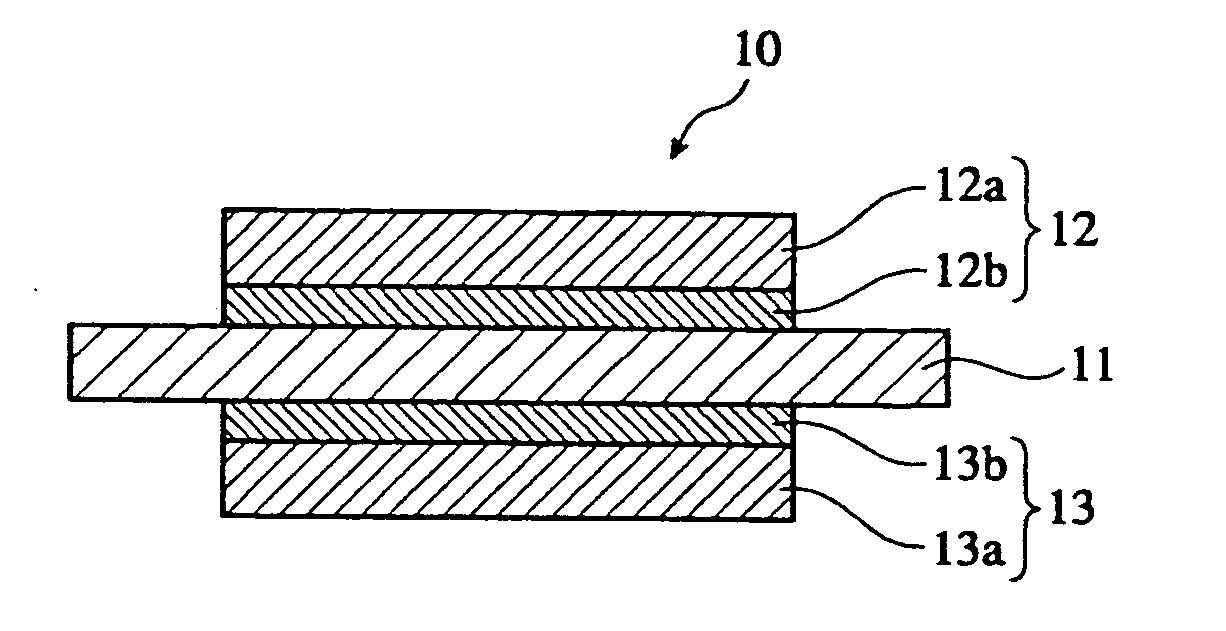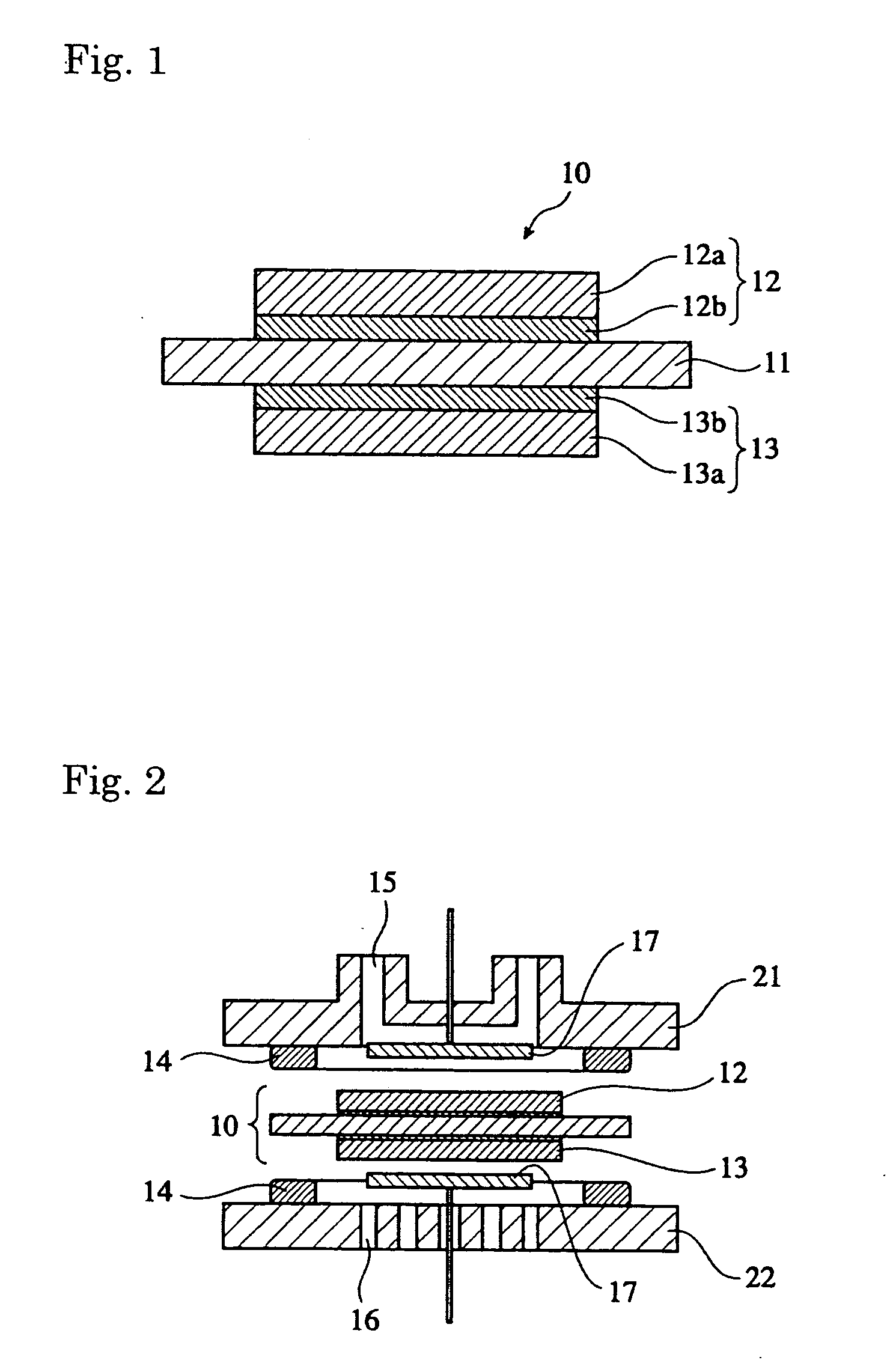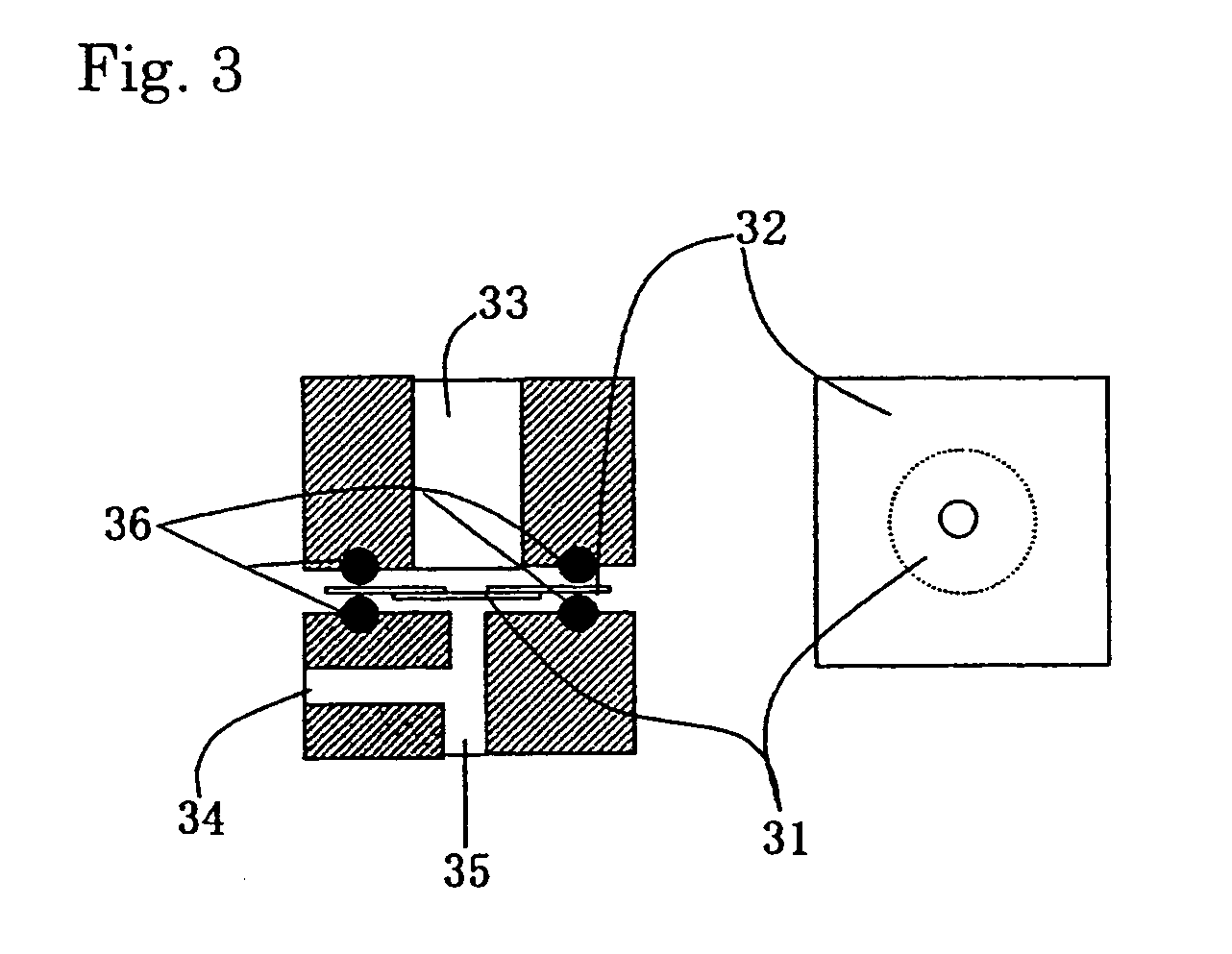Compound, and solid electrolyte, proton conductor, membrane electrode assembly and fuel cell comprising the compound
a fuel cell and solid electrolyte technology, applied in the field of compound, can solve the problems of low water content of solid electrolytic membrane in the cell, inability to obtain expected cell characteristics, and inability to solve problems, and achieve the effect of high ionic conductivity
- Summary
- Abstract
- Description
- Claims
- Application Information
AI Technical Summary
Benefits of technology
Problems solved by technology
Method used
Image
Examples
example 1-1
(1) Formation of Solid Electrolytic Membrane (E-1-1):
[0138] SO3-DMF complex (from Aldrich) (0.15 g) was added to a solution of DMF (0.5 ml) with A-14 (0.1 g) dissolved therein, and reacted at room temperature for 12 hours. Next, IV-2 (38 mg) and water (0.05 ml) were added to it, and stirred under heat at 60° C. for 4 hours. The resulting mixture was cast on a polyimide film (Upilex-75S by Ube Kosan), and left as such for 24 hours. Thus solidified, the coating film was peeled from the polyimide film, and washed with water. After dried, the film thus formed had a thickness of 120 μm.
(2) Formation of Solid Electrolytic Membrane (E-1-2):
[0139] SO3-DMF complex (from Aldrich) (0.15 g) was added to a solution of DMF (0.5 ml) with A-14 (0.1 g) dissolved therein, and reacted at room temperature for 12 hours. Next, IV-5 (73 mg) and water (0.11 ml) were added to it, and stirred under heat at 60° C. for 4 hours. The resulting mixture was cast on a polyimide film (Upilex-75S by Ube Kosan), ...
example 1-2
(1) Formation of Solid Electrolytic Membrane (E-2-1):
[0152] SO3-DMF complex (from Aldrich) (0.15 g) was added to a solution of DMF (0.5 ml) with A-14 (0.1 g) dissolved therein, and reacted at room temperature for 12 hours. Next, S-13 (207 mg) and water (0.11 ml) were added to it, and stirred under heat at 60° C. for 4 hours. The resulting mixture was cast on a polyimide film (Upilex-75S by Ube Kosan), and left as such for 24 hours. Thus solidified, the coating film was peeled from the polyimide film, and washed with water. After dried, the white film thus formed had a thickness of 120 μm. With a polarizing microscope, fine domains of optical anisotropy were confirmed in the film. From this, it is understood that the mesogen part of S-13 aggregated in a predetermined direction and its aggregates formed the film.
(2) Formation of Solid Electrolytic Membrane (E-2-2):
[0153] SO3-DMF complex (from Aldrich) (0.15 g) was added to a solution of DMF (0.5 ml) with A-14 (0.1 g) and S-13 (20...
example 1-3
(1) Formation of Solid Electrolytic Membrane (E-3-1):
[0163] SO3-DMF complex (from Aldrich) (0.93 g) was added to a solution of DMF (2.5 ml) with A-1 (0.50 g) dissolved therein, and reacted at room temperature for 12 hours. Next, water (80 μl) was added to it, and stirred under heat at 60° C. for 4 hours. The resulting mixture was cast on a Teflon sheet (Teflon®-the same shall apply hereinunder), and left as such for 72 hours. Thus solidified, the coating film was peeled from the Teflon sheet, and washed with water. After dried, the film thus formed had a thickness of 123 μm.
(2) Formation of Solid Electrolytic Membrane (E-3-2):
[0164] SO3-DMF complex (from Aldrich) (0.48 g) was added to a solution of DMF (2.5 ml) with A-6 (0.50 g) dissolved therein, and reacted at room temperature for 12 hours. Next, water (56 μl) was added to it, and stirred under heat at 60° C. for 5 hours. The resulting mixture was cast on a Teflon sheet, and left as such for 72 hours. Thus solidified, the coa...
PUM
| Property | Measurement | Unit |
|---|---|---|
| temperature | aaaaa | aaaaa |
| temperature | aaaaa | aaaaa |
| temperature | aaaaa | aaaaa |
Abstract
Description
Claims
Application Information
 Login to View More
Login to View More - R&D
- Intellectual Property
- Life Sciences
- Materials
- Tech Scout
- Unparalleled Data Quality
- Higher Quality Content
- 60% Fewer Hallucinations
Browse by: Latest US Patents, China's latest patents, Technical Efficacy Thesaurus, Application Domain, Technology Topic, Popular Technical Reports.
© 2025 PatSnap. All rights reserved.Legal|Privacy policy|Modern Slavery Act Transparency Statement|Sitemap|About US| Contact US: help@patsnap.com



